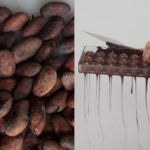Chocolate prices skyrocketed in 2024 - concretely, 130% - and prices are expected to continue rising in 2025. We'll examine some of the factors that influence the price of chocolate, and how a small change in purchasing decisions can help you get more bang for your buck.
What influences the price of chocolate?
The price of chocolate is established based on several factors. Climate and demand affect the availability of cacao, the raw product used to make chocolate. So it stands to reason that these two factors play a big role in the price you pay for your chocolate. A chocolate bar may also cost more or less depending on how much the farmers are getting paid and how many middlemen are involved in the production and supply chain, such as intermediaries who collect cacao from the farmers and sell it to companies who import cacao into non-cacao-producing countries, like countries in Europe or North America.
Climate and plant diseases
Cacao only grows in tropical areas, in the band stretching from 20 degrees above the equator to 20 degrees below the equator. These hot and humid regions supply the necessary heat and water for cacao plants to thrive, but it's a delicate balance and these areas are vulnerable to climate change.
On top of this, 2023 was the year of El Niño, a weather phenomenon that brought drier-than-usual weather to Ghana and the Ivory Coast. A lack of rain followed by too much rain at the wrong time had serious effects on the 2023 harvest in both these countries, which typically provide 70% of the cacao used worldwide between them.
In addition to the climate, other factors that affected the cacao harvest include plant disease , advanced plant age, and a lack of money on the part of the farmers leading to a failure to invest in caring for the land, with corresponding effects on its fertility.
Demand
Chocolate is enjoyed by an increasing number of people around the world, especially in the Asian market , which historically didn't consume as much. As choco-lovers we are of course very happy for chocolate to reach as many people as possible, but of course this also means the planet needs to produce more cacao in order to meet demand.
Consumer preferences have also evolved over the last few years, with more people opting for dark chocolate due to its potential health benefits. Dark chocolate has a higher percentage of cacao than milk or white chocolate, so it's more vulnerable to changes in the price of cacao as a commodity.
With cacao in such high demand, large companies have been forced to virtually empty their stockpiles, with the contents of cacao warehouses in London and New York falling 80% to reach levels not seen in 20 years. Without these reserves to cushion changes in price, cacao prices are more volatile.
Another factor is the stock market, since cacao futures can be traded and are subject to price changes just like any other stock.
Middlemen
The vast majority of the farmers who actually grow the cacao are paid very little, and these low wages lead to deforestation and child labour. An estimated 1.56 million children are working in cacao plantations in Ivory Coast and Ghana.
The farmers sell their cacao beans to middlemen who then sell them to large processing companies such as Nestlé or Barry Callebaut. These intermediaries and processing companies take a large chunk of the profit. When you buy a 3-euro chocolate bar in the supermarket, you can rest assured that the the farmers were only paid a few cents..
We can avoid this price inflation by buying chocolate from companies that work directly with the farmers. Generally, this system also sees the farmers earning a fairer wage.
Where do we source our chocolate at Danielle Pacheco Chocolatier?
At Danielle Pacheco Chocolatier, all of our chocolate is sourced from small companies with their own cacao plantations, most of them in Central America. We work primarily with chocolate from Xoco Gourmet, and we also use select couverture from Cluizel Paris and Original Beans.
This chocolate is more expensive than chocolate from Callebaut or other similar companies, but it guarantees fair wages and working conditions for the farmers, and results in a product that has been cared for from the very start to bring out the finest and most unique flavours.
Like most chocolate companies, we'll need to raise our prices in 2025. However, because our chocolate already comes from ethical, sustainable plantations and not from Ghana or Ivory Coast, we'll only need to raise our prices by about 10%. This reflects the rise in the prices we pay to our providers, who in turn pass those earnings on to the farmers so they can continue to enjoy good working conditions.



